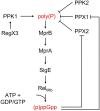Targeting the Mycobacterium tuberculosis Stringent Response as a Strategy for Shortening Tuberculosis Treatment
- PMID: 34690990
- PMCID: PMC8529327
- DOI: 10.3389/fmicb.2021.744167
Targeting the Mycobacterium tuberculosis Stringent Response as a Strategy for Shortening Tuberculosis Treatment
Abstract
The stringent response is well conserved across bacterial species and is a key pathway involved both in bacterial survival and virulence and in the induction of antibiotic tolerance in Mycobacteria. It is mediated by the alarmone (p)ppGpp and the regulatory molecule inorganic polyphosphate in response to stress conditions such as nutrient starvation. Efforts to pharmacologically target various components of the stringent response have shown promise in modulating mycobacterial virulence and antibiotic tolerance. In this review, we summarize the current understanding of the stringent response and its role in virulence and tolerance in Mycobacteria, including evidence that targeting this pathway could have therapeutic benefit.
Keywords: (p)ppGpp; Mycobacterium tuberculosis; antibiotic tolerance; hyperphosphorylated guanosine; inorganic polyphosphate; small molecule inhibitor; stringent response; vaccination.
Copyright © 2021 Danchik, Wang and Karakousis.
Conflict of interest statement
The authors declare that the research was conducted in the absence of any commercial or financial relationships that could be construed as a potential conflict of interest.
Figures
References
Publication types
Grants and funding
LinkOut - more resources
Full Text Sources


